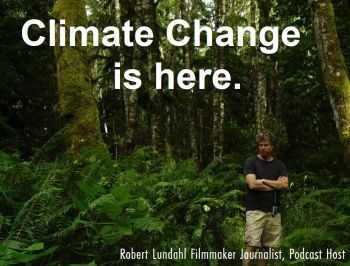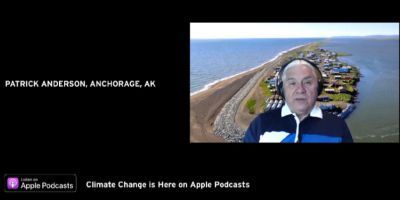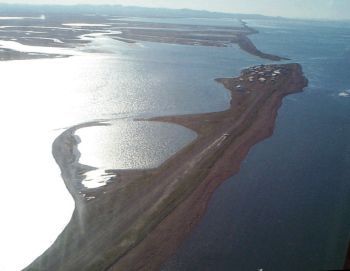
Publisher:
Bonnie King
CONTACT:
Newsroom@Salem-news.com
Advertising:
Adsales@Salem-news.com

~Truth~
~Justice~
~Peace~
TJP
Jun-01-2022 12:06

 TweetFollow @OregonNews
TweetFollow @OregonNews
The Climate Front: People Who Live There
Robert Lundahl special to Salem-News.comExplore the climate impacts to front-line communities in Alaska and the Lower 48.
 Filmmaker/Journalist Robert Lundahl reveals climate impacts to front-line communities. |
(LOS ANGELES, Calif.) - The story of humans and Climate Change, that is, for the most part, not on CNN, became tangible over the course of a year.
It began by dropping in on National Geographic Senior Producer Scott Ressler’s film, “The Last Ice,” for a “behind the scenes” interview about his five years in Greenland and Nunavut, Canada, around the Arctic Circle, where Inuit people hunt on the sea ice.
It became a necessity under lockdown to let the mind journey. It’s a long way from Scott’s home in Virginia and mine in California.
As the seasons changed in the Lower 48, 15 episodes of a Podcast Series, called “Climate Change is Here” from there came into being (climatechangeishere.com).
Documentary filmmaking, a medium with which I am familiar, usually incorporates interviews in some regard. I had learned to “read” the rhythms of speech, the nuances in the choice of words. The unknown and the unsaid.
We may think of filmmakers like David Lynch and Errol Morris, who let a little light splash, off the subject. As with a Rolling Stone interview, what is revealed is the person, the broader story, the context.
My interview with Patrick Anderson explores the impacts to front-line communities in Alaska and the Lower 48 as they confront not only intergenerational trauma, but the traumas of climate change as well.
PATRICK ANDERSON
Robert Lundahl:
Patrick, could you introduce yourself and give us a little bit of background on your activities in Alaska in the field of health?
Anderson:
I certainly can, Robert. My name is Patrick Anderson, and I am myself Alaska native. I come from two different tribes so in my culture, being matrilineal, we claim our mother's tribe as our predominant tribe.
So I am Tlingit Indian, and I come from the Eagle moiety and one of the clans in the Eagle moiety is mine, the Shangukeidí, or Thunderbird - so I was born in Alaska - ended up living in Seattle for a number of years, fortunate in some ways, unfortunate in others, but to that, background, led me to an undergraduate degree at Princeton University and a law degree at the University of Michigan.
So when I returned to the state of Alaska, I came back listening to my mother's voice - which is that you know after you've finished all of that you really should go back to Alaska and to help Alaska native people, so that's what I did and here I am, about 50 years later.
Robert Lundahl:
We talked about a number of things and one of them was where to begin –
Because, in our group at City University of New York, Hunter College - The Greenbelt Society in the Department of Geography and Environmental Science - we were talking about environment and climate change and you brought up health issues involving toxic stress and other matters that impact native Alaskans disproportionately.
Can you introduce us to that concept and what you meant by that and how it fits into the bigger picture of environment?
Anderson:
I sure can Robert. Later in my career, I began to think that law was not really the field I wanted to be in, and the first position that I was hired to, was a compactor, which is an Alaska native organization that operates a contract with the United States government to administer health care within a certain region.
During my tenure at that first job I came across a study, that to me, explained a lot of the issues that Alaska natives have faced.
My mother attended a Catholic boarding school for her primary school and went to a Bureau of Indian Affairs boarding school for high school – that was framed in a different way after I became familiar with the adverse childhood experience study and later on the whole world of toxic, tolerable, and normal stress.
 (fig. 1) Patrick Anderson |
I'm not trained as a psychologist, I'm not - I wasn't really into biology, chemistry...
But, since discovering the adverse childhood experience study I have related it to a number of root causes of problems and issues that not only Alaska natives but non-natives have faced, particularly in Alaska.
And so in the world of toxic stress behind me (fig 1) is the Village of Kivalina.
Within that community a very high number of residents will have significant amounts of experience that could qualify them to be a regular sufferer of toxic stress.
There are a lot of neurobiological and physical and chemical reactions to the stress response that I won't go into but what it does is it affects normal day-to-day living for all people.
When we were talking about climate change, if that was an empty peninsula behind me, there's no problem or issues - nature tears land up constantly but when you put people onto it not only changes the dynamics based on location based on the kind of weather that hits it but it changes dynamics because there are now people there who have lives and their lives are impacted and affected by what happens to them.
If they're used to it, if it's normal, that is a different response than if it is unusual and out of the ordinary, so toxic stress has been a huge part of my thinking in terms of the root causes of a lot of problems that strike Alaska over the past half a century, or actually more than a century.
Robert Lundahl:
What are the challenges that native Alaskans in a village like Kivalina face specifically?
Anderson:
Well, the first is that the largest community next to Kivalina is Kotzebue. Kotzebue has about 3,000 people – its not a real large community - it's rural by U.S standards, but it is the regional hub and so in order to get to Kivalina, which has no roads, you need to fly from Kotzebue or from Anchorage.
 |
I think it's a seven thousand eight thousand gallon tank in Kivalina and from there they have to purify it – and from that point, I don't believe all of the homes are connected and in order to get water sometimes you have to drive to, not in a vehicle necessarily, but you have to have water picked up and delivered to your home, same thing is true with fuel.
The Chukchi sea and that area around Kivalina is covered in ice for a lot of the winter, and as a result, there aren't any barges coming in with fuel so there are some huge fuel tanks that carry all of the fuel supply for the community for the entire year.
They fill it maybe once a year they have to have the money to be able to do that and in addition they have to have good weather and they have to schedule the barge in order to be able to commit plus the financing that comes in...
...and then the infamous honey bucket that was in some places still used, but people don't have sewer systems so they have to take their raw sewage and take it to a lagoon...
...and the challenge is of course for food is that by the time an apple gets from Washington state to Kivalina it's not very appetizing or appealing, and as a result a lot of western diet, which has been introduced into many of our communities is very expensive.
Milk can cost ten, eleven, twelve dollars a gallon.
Fuel can cost seven, eight, nine, dollars a gallon, and because the average temperature in this area during January is about fifteen degrees below zero, you use a lot of fuel.
So there are a lot of challenges that exist within a small community like Kivalina, created by its remoteness, by its lack of infrastructure and by lack of good paying jobs.
Having the ability to survive there in a very high cost environment multiple challenges and that's in addition to the health challenges that exist - just having a child can be very complicated in a village like Kivalina.
So, when a pregnant female is within a certain period of time for delivery, she is taken to Kotzebue where she spends three, four, five, or six weeks depending on the seriousness of the pregnancy, waiting for the child to be born, if it's a high risk pregnancy then it's into Anchorage where they will wait for the same period of time.
I think of the word empathy, and some of us in the lower 48, you know, we think climate change is a large issue that we can't really get our heads around and it seems to be more of a political issue sometimes but here in Kivalina, we have a different perspective.
Robert Lundahl:
What would you like people to understand in terms of empathy for the people there?
Patrick Anderson:
First of all, the people in Kivalina and in the northwest Arctic are extremely hardy. They have survived and thrived in an environment where most people wouldn't even consider living, and they've done it by extensive use of local resources, so in the area around Kivalina, the local people still harvest whale. They don't get very many whales.
One of the problems that's occurred is that as the pack ice is retreated in the northwest Arctic, it's taken away the ability of whale hunters to get out to where the migratory paths are, but traditionally a whale or two would be harvested and would provide a lot of food for the community - walruses, caribou, whitefish, and in addition to that a great deal of trade so there's an extensive trade network of individuals all over the northwest Arctic and the North Slope, who, when they get foods that they have unique access to, will trade.
So there's a great deal of hardiness and survival, but when a traditionally nomadic people were located in one central area it was to have access to education and to services like healthcare.
The brutal truth about native life back in the 40s 50s and 60s is that there was a lot of disease, a lot of health issues, and so providing health care services in a remote area like this is challenging.
Kivalina has a community health aid clinic where they do evaluations of routine types of problems and issues, but then individuals who have more serious problems will go into either Kotzebue or into Anchorage for medical treatment.
Weather hampers that quite a bit and there are severe weather patterns that exist up here. The same pack ice that I talked about that has been retreating, also protects this peninsula from the worst ravages of winter storms - the pack ice itself absorbs a lot of the impacts, a lot of the water doesn't then wash up onto the very fragile peninsula.
On top of that the warming climate is melting the permafrost so when that permafrost is no longer there, the soil is more uh - it's more difficult to protect so in all the pictures that you see of Kivalina there are a lot of rocks around it.
The rocks are there to try to protect the soil that exists, and then the migratory patterns and the fish - they live in a certain temperature – they return at a certain time of the year and when the climate starts to shift you find that those migratory patterns shift. It may be more expensive to get out to where the resources are.
I mentioned fuel can cost eight, nine, ten dollars a gallon and you don't go by miles per gallon in a small boat, you go by gallons per hour, and when you're spending a few hundred dollars to try to get out to a place to harvest something, the cost becomes sometimes prohibitive. Same is true with bullets.
Bullets have been very expensive in the Northwest Arctic for quite some time now so all of these challenges come together and add to the stress that the community is experiencing, and that interaction, that systems interaction between people their food sources, uh climate, the place that they live, is just, it can become overwhelming at times.
(End Part 1.)
Robert Lundahl:
We’ll continue my interview with Patrick Anderson in Part 2, People Who Live There. Next time.
Patrick Anderson, Thunderbird Clan (Tlingit). Attorney, Health Administrator and Tribal Manager, discusses the Health of Alaska Natives in the era of Climate Change. Patrick most recently served as CEO of Alaska RurAL Cap, and as a long-term Board Member of Sealaska Corporation. Patrick’s focus is on Toxic Stress, Adverse Childhood Experiences (ACEs), intergenerational trauma, and their remedies. Visit patrickandersonsfuturestate.com.
Articles for May 31, 2022 | Articles for June 1, 2022 |
Quick Links
DINING
Willamette UniversityGoudy Commons Cafe
Dine on the Queen
Willamette Queen Sternwheeler
MUST SEE SALEM
Oregon Capitol ToursCapitol History Gateway
Willamette River Ride
Willamette Queen Sternwheeler
Historic Home Tours:
Deepwood Museum
The Bush House
Gaiety Hollow Garden
AUCTIONS - APPRAISALS
Auction Masters & AppraisalsCONSTRUCTION SERVICES
Roofing and ContractingSheridan, Ore.
ONLINE SHOPPING
Special Occasion DressesAdvertise with Salem-News
Contact:AdSales@Salem-News.com

googlec507860f6901db00.html



Terms of Service | Privacy Policy
All comments and messages are approved by people and self promotional links or unacceptable comments are denied.
John Miller June 1, 2022 3:00 pm (Pacific time)
Very good interview. The situation of Kivalina is made abundantly clear.
[Return to Top]©2025 Salem-News.com. All opinions expressed in this article are those of the author and do not necessarily reflect those of Salem-News.com.